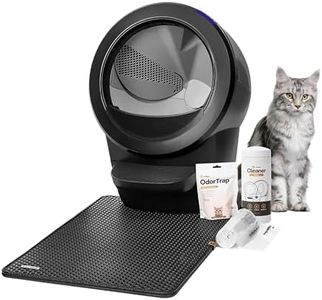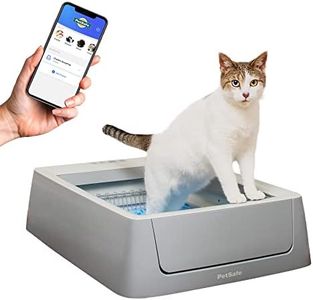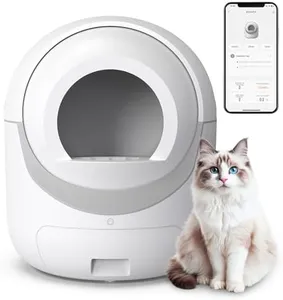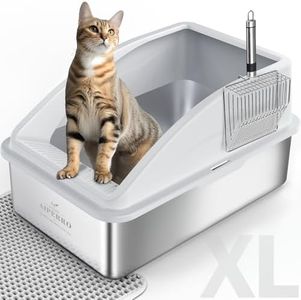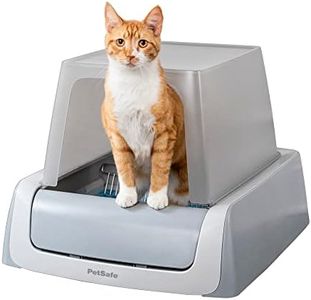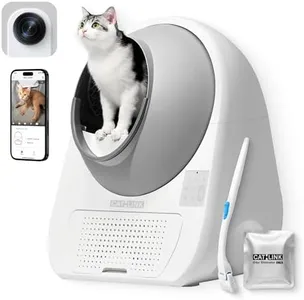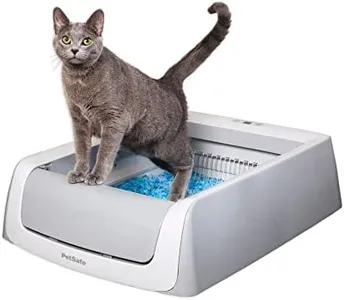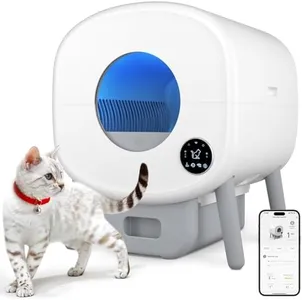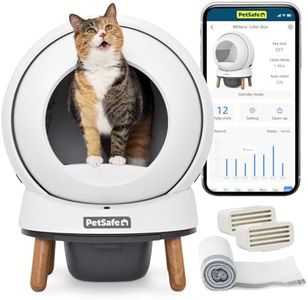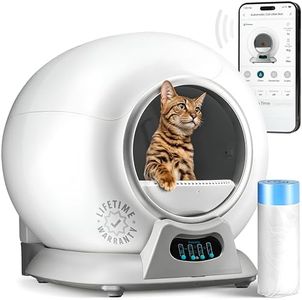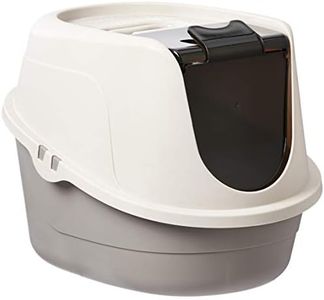10 Best Cat Litter Boxes 2025 in the United States
Our technology thoroughly searches through the online shopping world, reviewing hundreds of sites. We then process and analyze this information, updating in real-time to bring you the latest top-rated products. This way, you always get the best and most current options available.

Our Top Picks
Winner
Litter-Robot 4 Core Bundle by Whisker, Black - Automatic, Self-Cleaning Cat Litter Box, Includes Litter-Robot 4, 6 OdorTrap Refills, 25 Liners, 30 Cleaner Wipes, Mat & Fence
Most important from
489 reviews
The Litter-Robot 4 Core Bundle by Whisker is an advanced, automatic, self-cleaning cat litter box designed to make pet care more convenient. One of its standout features is the self-cleaning mechanism that eliminates the need for manual scooping by automatically sifting and separating waste from clean litter. This is particularly beneficial for households with multiple cats, as it supports up to four cats weighing at least 3 lbs each.
The included Whisker app enhances convenience by allowing real-time monitoring and control of the litter box, including tracking waste levels and your cat's weight after each use, which can be quite useful for health monitoring. The bundle also comes with additional accessories like OdorTrap refills, waste drawer liners, cleaner wipes, a mat, and a fence, all designed to improve hygiene and reduce litter tracking and odor.
However, the unit is quite large, with dimensions of 24 x 24 x 34 inches and weighing 24 pounds, which might require substantial space. Additionally, it is on the pricier side, which could be a consideration for budget-conscious pet owners. Setting up the device on a firm surface is crucial for accurate functioning, which might limit placement options. The Litter-Robot 4 is best suited for cat owners looking for a high-tech solution to litter maintenance, especially those with multiple cats and a preference for minimizing direct involvement in litter cleaning.
Most important from
489 reviews
Fumoi Self Cleaning Litter Box,95L Automatic Cat Litter Box Self Cleaning Large Capacity for Multiple Cats, App-Controlled with Safety Sensors, Removable Washable Liner,2 Rolls Garbage Bags,Grey
Most important from
314 reviews
The Fumoi Self Cleaning Litter Box is designed for multiple cats, featuring a large 95L capacity suitable for cats weighing between 2.2 to 33 lbs. The 15L waste bin can handle waste for up to 15 days, making it ideal for users who may be away for extended periods. Its advanced safety sensors ensure that the cleaning process pauses when your cat is near, providing safety and peace of mind.
The box operates quietly, maintaining a calm home environment, and its detachable, washable liner makes cleaning simple. Additionally, the built-in deodorizing design helps control odors, keeping your home fresh. The smart app control allows users to manage the litter box remotely, with features like auto-clean, waste disposal, and health tracking, though it is only compatible with 2.4G Wi-Fi.
This automated litter box can accommodate most types of cat litter, ensuring versatility. However, its size (21.6 x 19.6 x 25.8 inches) and weight (30.6 pounds) may make it less convenient for small spaces or frequent moving. The product's modern design and durable materials (polypropylene and ABS) are strong points, but the higher price and requirement for power may be a downside for some users. It is particularly suitable for cat owners looking for convenience and advanced features, especially those with multiple cats or busy schedules.
Most important from
314 reviews
PetSafe ScoopFree Crystal Smart Self-Cleaning Cat Litter Box - WiFi & App Enabled - Hands-Free Cleanup With Disposable Crystal Trays - Less Tracking, Superior Odor Control - Includes a Disposable Tray
Most important from
12544 reviews
The PetSafe ScoopFree Crystal Smart Self-Cleaning Cat Litter Box is a high-tech solution for cat owners seeking hands-free maintenance. This litter box is designed to automatically clean itself, running a cleaning cycle 20 minutes after your cat exits. It features an app-connected system that allows you to monitor your cat's usage and health through your smartphone, providing peace of mind whether you're home or away.
The included crystal litter offers superior odor control and minimal tracking, with waste being swept into a covered trap to lock away smells effectively. The product dimensions are 27.6 x 19.1 x 6 inches, making it suitable for indoor use and accommodating all cat breeds up to a weight limit of 15 kilograms. One notable advantage is the pre-filled, disposable trays that make clean-up simple without the need to touch or see the waste.
However, the box is uncovered, which might not be ideal for cats that prefer privacy. Additionally, the requirement to use only ScoopFree Premium Crystal Litter could be limiting and potentially more costly in the long run. The box weighs 18 pounds and comes with a one-year limited warranty. This litter box offers many conveniences, but its high-tech features might be daunting for less tech-savvy users, and the initial cost and ongoing expense of proprietary litter trays should be considered.
Most important from
12544 reviews
Buying Guide for the Best Cat Litter Boxes
Choosing the right cat litter box is essential for both your cat's comfort and your convenience. A good litter box can help maintain cleanliness, reduce odors, and ensure your cat feels safe and comfortable. When selecting a litter box, consider your cat's size, age, and habits, as well as your own preferences for maintenance and placement. Here are some key specifications to consider when choosing a cat litter box.FAQ
Most Popular Categories Right Now


